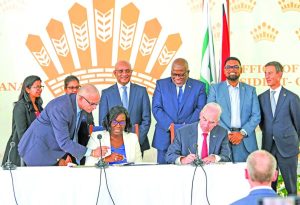– FITUG urges Govt to continue making up for time lost between 2015-2020
The Government of Guyana has come in for praise from the Private Sector Commission (PSC) and the Guyana Oil and Gas Energy Chamber (GOGEG), for Friday’s signing of a historic agreement with Hess for the oil company to purchase 2.5 million carbon credits annually from Guyana.
According to the PSC in its statement, the Government of Guyana is to be commended on its visionary leadership which has resulted in Guyana becoming the first country to be issued carbon credits for successfully preventing forest loss and degradation under the REDD+ initiative.

“The Commission strongly believes that the deal signed on December 2, 2022, between the Government and Hess Corporation for Guyana to be paid a minimum of US$750 million between 2016 and 2030, is a demonstration of Guyana’s commitment towards global climate action.”
“Importantly, the deal shows what corporations like Hess, a partner in the Stabroek Block Offshore Guyana, can do to demonstrate leadership and action in the fight against climate change,” the PSC also noted.
According to the PSC, it is envisioned that the funds to be provided from this historic agreement will go a long way towards realising the objectives outlined in the Low Carbon Development Strategy 2030 (LCDS).
GOGEC
Meanwhile, GOGEC in its statement also commended the Government for this agreement, which will net Guyana US$750 million. GOGEC President Manniram Prashad noted that even though Guyana’s oil production will reach 1 million barrels per day by 2030, the country will still enjoy the benefits of its net negative carbon emissions.
“In a broader framework, to move towards climate resilience, countries would need to design disaster risk reduction and climate change adaptation strategies. The objective in so doing is to build climate-resilient economies while simultaneously developing creative financing solutions over the long term to be able to adequately respond to the financial and economic damages whenever such risks occur in member states.”
According to Prashad, Guyana’s expanded Low Carbon Development Strategy (LCDS) framework and now this innovative carbon credit model, demonstrates the Government’s stewardship in successfully leading in these respects.
He noted that LCDS 2030 sets out the vision for a low-carbon economy through low-carbon energy, employment and development opportunities, and investment in adapting to the impacts of climate change.
“The average annual weather-related disaster losses in the last five to ten years in “low” and “lower-middle” income countries have reached US$1.3 billion and US$6.8 billion, respectively,” Prashad said.
“Climate impacts undermine resilience and the capacity to recover and absorb losses from these events, especially that of poorer countries and their citizens, by reducing their agricultural productivity, weakening water and food security, increasing the incidence of diseases, and threatening the existing infrastructure, economic productivity, and value chains.”
In light of all the climate change impacts, the GOGEC President noted that more focus is needed on the more vulnerable groups who are the victims suffering the most from the wrath of such catastrophes.
“This should not only be limited to sustainable development work to lift people out of poverty by economic empowerment through education, but countries also must divert investment into building climate resilient infrastructure,” he said.











